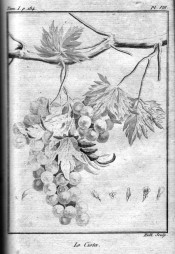Vitis vinifera ‘Ciotat’
‘Bunches nearly the size of the White Muscadine. Berries round, white, of a middling size, with a thin skin, and a delicate juicy flesh, which is very sweet, but not highly flavoured. The leaves are finely divided, wholly different from any other sort. It will ripen pretty well on a south wall, in a warm season; but the bunches are larger, and the berries much better flavoured, in the vinery.’ [George Lindley – Orchard Guide p.208/1831].
Horticultural & Botanical History
‘Miller says it was originally brought from Canada, where it grows wild in the woods. This is probably a mistake, which may have arisen from Cornutus having inserted it in his work. It was cultivated here by John Tradescant, jun., in 1656.’ [George Lindley – Orchard Guide p.208/1831].
Figured in L’Art de Faire, Gouverner et Perfectionner les Vines [Chaptal Fig.8/1801], the illustration used here.
History at Camden Park
Listed in all published catalogues as ‘ditto Parsley-leaved’. This is shorthand for ‘Parsley-leaved Chasselas’ [Vines for Table Only no.9/1843].
Notes
Published Jun 23, 2010 - 12:33 PM | Last updated Jul 21, 2011 - 12:40 PM
| Family | Vitaceae |
|---|---|
| Category | |
| Region of origin | Garden origin, unknown |
| Synonyms |
|
| Common Name | Grape, Table Grape |
| Name in the Camden Park Record |
ditto Parsley-leaved |
| Confidence level | high |
